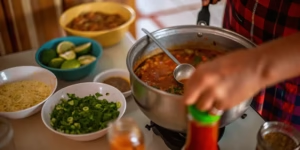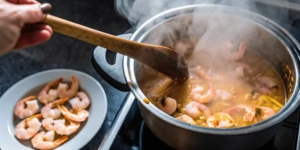Close your eyes and picture this: a gentle sea breeze, the buzz of Bahian street life, and the comforting scent of garlic and coconut simmering away. That’s what this moqueca delivers—all in one bowl. It’s more than a recipe; it’s a quick escape to Brazil’s sun-drenched coastlines via flavor.
This version of Moqueca de Camarão brings together tender shrimp bathed in creamy coconut milk, bright lime, and just the right touch of chili. But don’t worry—it’s easy to make, even on a weeknight. I’ve simplified traditional steps to fit your kitchen without losing the dish’s soul.
Whether you’re curious about global cuisine, craving a warm one-pot meal, or trying something new for dinner, this moqueca is here to deliver: balanced, rich, and deeply satisfying.
Inside this post you’ll find:
- A streamlined, authentic recipe for everyday cooks
- Cultural backstory that makes the dish meaningful
- Variations and expert tips—from choosing shrimp to dialing spice
Ready? Let’s bring a taste of Brazil to your table.
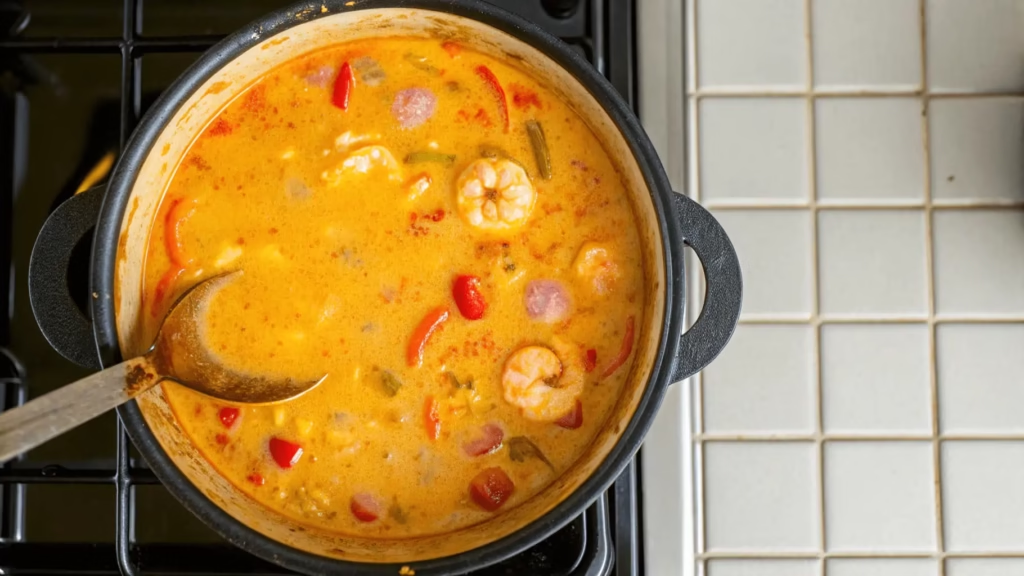
Table of Contents
What Is Moqueca de Camarão?
At its heart, Moqueca de Camarão is a story told through a stew — one passed down across Brazilian generations, across kitchens that hum with life, laughter, and spice. The name moqueca comes from an indigenous word moquem, meaning “to cook slowly in a clay pot.” And while variations exist, the shrimp-based version (de camarão) is one of Brazil’s most beloved expressions of this culinary tradition.
But this dish isn’t uniform. Brazil is massive, and moqueca varies from region to region. In the state of Bahia, moqueca typically bursts with color and richness — thanks to coconut milk and dendê oil (a bright red palm oil that brings a deep, earthy flavor). Meanwhile, in Espírito Santo, a lighter version exists — no coconut milk, no dendê — but still loaded with flavor, thanks to annatto oil and fresh herbs.
This recipe leans toward the Bahian style but simplifies a few traditional ingredients to keep it accessible no matter where you’re cooking. Instead of dendê, for example, we’ll use olive oil (with an option to go traditional if you can find it). The result? A dish that’s fragrant, vibrant, and grounded in history — but approachable enough for your Tuesday night dinner.
What makes it special isn’t just what’s in the pot — it’s how moqueca brings people together. It’s served bubbling hot at the center of the table, often with a side of rice or farofa, meant to be shared. That alone makes it feel like more than food — it’s a moment.
The Story Behind This Stew
Moqueca isn’t just a recipe—it’s a rhythm, a ritual, a memory passed from kitchen to kitchen across Brazil. It’s the kind of dish that smells like home before you even taste it, bubbling slowly while people talk, gather, argue, laugh.
In Bahia, where Afro-Brazilian culture runs deep, moqueca is layered with heritage. It’s shaped by Indigenous cooking methods, West African ingredients, and Portuguese influences—all stewed into something uniquely Brazilian. That’s where dendê oil shows up: bold, earthy, unapologetic. Coconut milk adds softness. Lime brings the sun. Each bite carries a little history.
Traditionally, moqueca is cooked in a clay pot called a panela de barro, often made by hand by women artisans in Espírito Santo. The pot itself seasons over time, absorbing flavor from every stew it holds. You can’t rush moqueca—it’s about the long simmer, the slow release of aromatics, the patience of people who know food isn’t just fuel.
And while today’s recipe is simplified for weeknight ease, it still tries to honor that spirit: slow where it matters, generous in flavor, and shared in a way that makes dinner feel like a gathering.
Curious to learn more about the origins and regional styles of moqueca? Check out the full Wikipedia entry here.
Is Moqueca Always Made with Shrimp?
Not always. While Moqueca de Camarão uses shrimp, other popular versions include:
- Moqueca de Peixe (white fish like snapper or cod)
- Moqueca Mista (a mix of seafood)
- Moqueca Capixaba (lighter, often tomato-forward, with annatto oil)
The core is the same: seafood, aromatics, and a slow simmer — but the details flex with geography and family tradition.

Moqueca de Camarão: The Brazilian Shrimp Coconut Stew
Equipment
- Large sauté pan or Dutch oven
- Wooden spoon
- Knife + cutting board
- Small bowl (for marinating shrimp)
Ingredients
- 1 lb (450g) large shrimp, peeled and deveined
- Juice of 1 lime
- 3 garlic cloves, minced
- 1 tbsp olive oil (or dendê oil if available)
- 1 medium onion, thinly sliced
- 1 bell pepper (red or yellow), thinly sliced
- 1 medium tomato, chopped
- 1 can (13.5 oz) full-fat coconut milk
- 1 tsp paprika
- ½ tsp chili flakes (optional)
- Salt and pepper to taste
- 2 tsp chopped cilantro, plus more for garnish
- 1 tbsp tomato paste (optional for richness)
- Lime wedges, for serving
Instructions
Marinate the shrimp:
- In a bowl, combine shrimp, lime juice, half the minced garlic, and a pinch of salt. Set aside while prepping other ingredients (10–15 minutes).
Sauté the aromatics:
- Heat olive oil or dendê oil in a large pan. Add onion and bell pepper. Cook 5–6 minutes until softened. Add remaining garlic and paprika. Stir for 30 seconds.
Add tomatoes + coconut milk:
- Stir in the chopped tomato and tomato paste (if using). Pour in coconut milk. Bring to a gentle simmer and season with salt, pepper, and chili flakes.

Cook the shrimp:
- Add marinated shrimp and cover. Cook for 4–5 minutes, or until shrimp are just pink and curled. Don’t overcook.

Finish + serve:
- Stir in chopped cilantro. Taste and adjust seasoning. Serve hot with lime wedges and your choice of rice or cauliflower rice.
Video
Notes
- Use dendê oil if you want a traditional Bahian flavor — start with 1 tbsp.
- Add more chili if you like it spicy 🌶️
- This dish tastes even better the next day — perfect for make-ahead meals.
- Try swapping shrimp for chunks of white fish or mixed seafood.
Expert Tips to Make It Your Own
Want to make your moqueca unforgettable — and maybe even a little yours? Here are some easy ways to level it up without messing with its roots:
- Don’t overcook the shrimp.
Once they turn pink and curl slightly, pull the pot off the heat. They’ll finish cooking as the stew rests. Overcooked shrimp get tough fast — and that’s a mood killer. - Can’t find dendê oil? Use olive oil, but…
If you can track down dendê (red palm oil), it adds a rich, earthy punch that’s hard to fake. Start small — it’s potent. No stress if you skip it, though. Olive oil still gets you there. - Adjust the spice to match your vibe.
Moqueca isn’t traditionally spicy-hot, but a little fresh chili or a pinch of flakes 🌶️ can dial up the warmth if you’re into it. Add slowly — it builds. - Finish with fresh lime juice.
A generous squeeze of lime 🍋 at the end balances out the coconut and brightens the whole dish. It’s like that last splash of sunlight on a good beach day. - Want deeper flavor? Let it rest.
Give the stew 10–15 minutes to settle after cooking. The flavors round out and mellow in the best way.
Serving Suggestions That Hit Just Right
Moqueca isn’t just a main dish — it’s a full experience. It’s meant to be brought to the table in the pot it was cooked in, bubbling and fragrant, ready to be ladled into bowls and shared. Whether you want to keep it classic or go light and modern, here’s how to round it out:
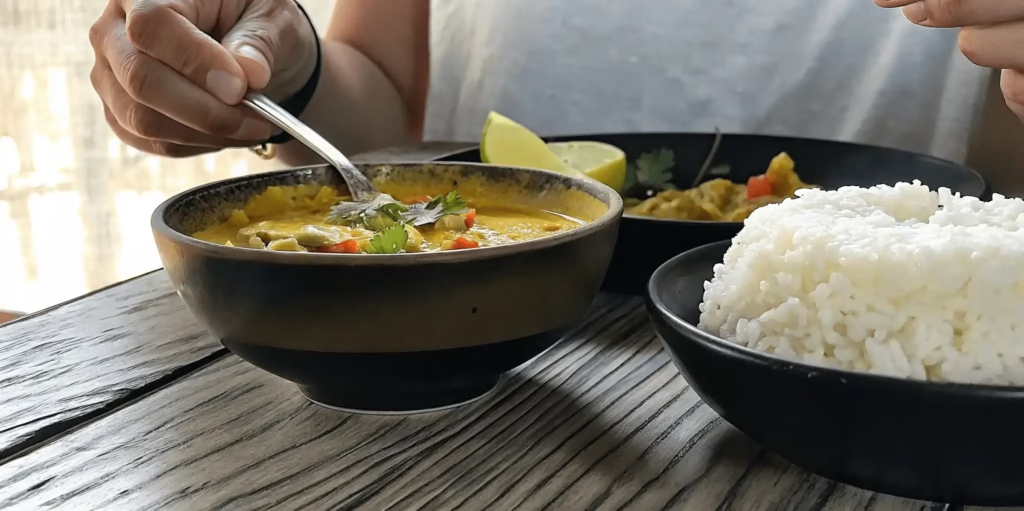
- Classic combo:
Serve it with fluffy white rice — that’s the traditional side. The rice soaks up the coconut-rich broth and keeps things satisfying without overpowering the flavors. - Light + low-carb:
Swap the rice for cauliflower rice or even a spoonful of mashed white beans. You still get that stew + starch vibe, but with fewer carbs and a lighter finish. - Go all-in Brazilian:
If you want the full Brazilian spread, serve moqueca with:- Farofa — toasted cassava flour (a crunchy, nutty sidekick)
- Pirão — a creamy paste made by mixing moqueca broth with manioc flour
- Lime wedges, chopped cilantro, and maybe a bit of hot sauce on the table for people to customize their bowl
- For something different:
Try it over quinoa or ladled into a bowl with crusty bread on the side. Not traditional, but comforting in a whole new way. - Drinks that work:
A cold beer pairs beautifully 🍺. Or, if you’re feeling festive, a caipirinha (Brazil’s signature lime cocktail) keeps the tropical mood alive 🍹.
No matter how you serve it, moqueca is a crowd-pleaser. It’s rich but not heavy, bold but not overwhelming — and always welcome at the table.
How to Store and Reheat Moqueca Without Losing Flavor
Moqueca might taste best fresh out of the pot, but the good news? It holds up surprisingly well the next day — and in some cases, might even taste better after the flavors have had time to mingle.
Here’s how to store it like a pro:
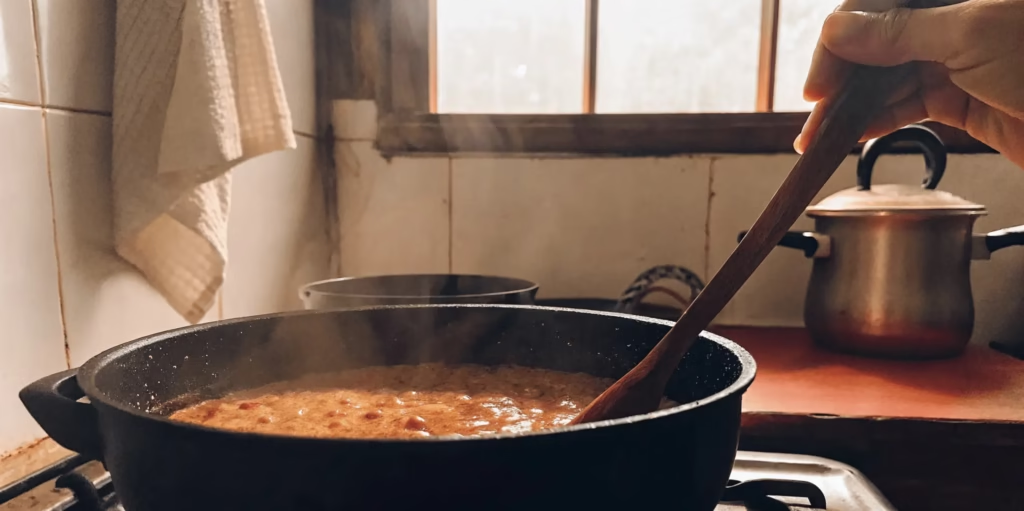
- Refrigerate properly:
Let the stew cool completely before transferring to an airtight container. It’ll keep in the fridge for up to 3 days. Just be sure the shrimp are fully submerged in the broth to prevent drying out. - Reheat gently:
Use a saucepan over low heat, stirring occasionally. Avoid boiling — shrimp are delicate, and a hard reheat will toughen them. You want slow, even warming. - Microwave with caution:
If you’re short on time, reheat a single portion in the microwave at 50% power in 30-second intervals, stirring in between. Add a splash of water or coconut milk if it thickens too much. - Can you freeze it?
You can, but shrimp don’t always love the freezer. Their texture can get a bit mealy after thawing. If you do freeze it, try to eat it within 1 month, and thaw it overnight in the fridge before reheating gently. - Freshen it up:
When reheating, try squeezing in a bit more lime or tossing in a pinch of fresh herbs right before serving. It perks everything back up.
Leftover moqueca makes an amazing lunch the next day — just don’t forget the rice (or cauliflower rice) to go with it.
Conclusion
Moqueca de Camarão isn’t the kind of recipe you rush through. It’s slow, steady, and layered — like the culture it comes from. And the beauty of this dish? It welcomes you in, whether you’re cooking it in a tiny apartment kitchen or a beachside home in Bahia.
At its core, it’s a celebration of balance — bold flavors that don’t overwhelm, comforting textures without heaviness, tradition without rigidity. You can make it your way and still honor where it came from.
So the next time you want something special — not fancy, just soul-filling — give this stew a place at your table. It’s not just another global recipe. It’s one you’ll come back to.
For more recipes from around the world check the Global Cuisines posts

